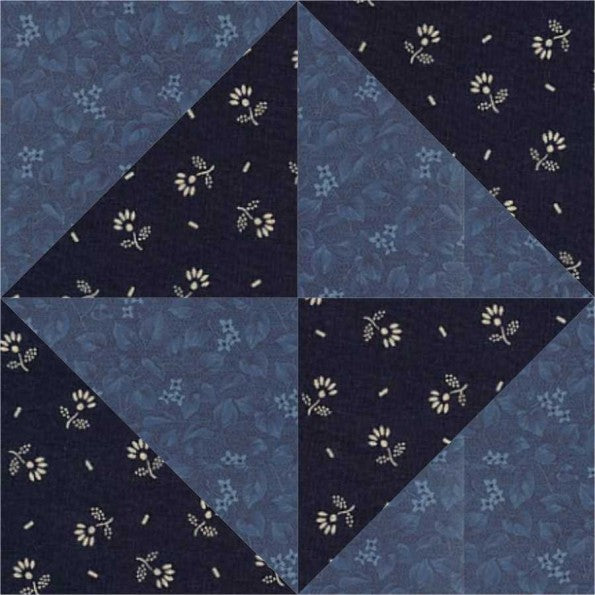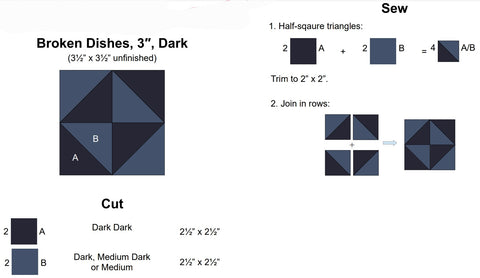
Broken Dishes Quilt Block Pattern

To keep these classes free please leave a donation for the teacher here. https://customclothingboutique.com/products/donat-to-motley-muse

Click here for a beginner in depth sewing class on all the basics. https://customclothingboutique.com/pages/quilting-knowledge
Sewing a broken dishes quilt block can be a fun and rewarding project, but it can also be a bit challenging if you're new to quilting. Here's a step-by-step guide on how to sew a broken dishes quilt block:
-
Gather your materials: You will need fabric, a rotary cutter, a cutting mat, a ruler, pins, a sewing machine, and coordinating thread.
-
Cut your fabric: To make a broken dishes quilt block, you will need two different fabrics in contrasting colors. Cut two 5-inch squares from each fabric.
-
Make half-square triangles: Place one square from each fabric right sides together and pin them in place. Use a ruler and rotary cutter to cut diagonally across the square, from one corner to the opposite corner. You should now have two triangles in each fabric.
-
Sew the triangles together: Take one triangle from each fabric and place them right sides together, with the long sides aligned. Sew a 1/4 inch seam along the long side. Repeat with the remaining triangles.
-
Press the seams: Press the seams open to reduce bulk.
-
Trim the blocks: Use a square ruler to trim the blocks to 4 1/2 inches square.
-
Arrange the blocks: Arrange the blocks in a broken dishes pattern, with one fabric in the center and the other fabric on the outer edges.
-
Sew the blocks together: Pin the blocks together and sew a 1/4 inch seam along each edge.
-
Press the seams: Press the seams open to reduce bulk.
-
Trim the block: Use a square ruler to trim the block to 8 1/2 inches square.
Congratulations! You've just sewn a broken dishes quilt block. Repeat these steps to create additional blocks and arrange them to make a beautiful quilt.
This is a great technique for making half square triangles that eliminates the need to directly manipulate the stretchy bias of the triangle. It utilizes two easy to cut squares producing two half square triangles.
On the back of the lighter fabric, draw a pencil line, diagonally from corner to corner.

Stack a pair of light and dark squares, right sides together. Sew a 1/4 inch seam allowance on each side of the line.

You will end up with something like this.

Now cut along the diagonal line.

Press the seam together to set the seam. Then press towards the darkest fabric.

To trim the block to the exact size line up the diagonal 45°angle with the ruler on your seam.

And then carefully trim your block with a rotary cutter.

The secret to the perfect four patch is all about ironing seams so that they butt together when the seams are joined. You may make the four patch by cutting individual squares if you want to make a scrappy quilt or only a few blocks to make with pre-joined strips. I'll take you through both methods.

Cut two A squares and two B squares in your required size. Chain piecing, join A square to a B square, right sides together, with a scant 1/4 inch seam allowance. Press towards the dark fabric.
This is your result:

This is also the result of cutting across pre-joined strips to create two units.
To make a standard four patch, the width of the unit cut from pre-joined strips is the same as the width of the original strips.
Press all the seams towards the dark fabric so that the seame butt-up.
Take the two A/B and place them right sides together, butting seams. Pin if required. Join with a scant 1/4 inch seam allowance, then press.

Wider Application:
You can apply this technique to all kinds of four patch blocks. As long as a block has a 4x4 grid, no matter how many pieces, the basic principles apply. It is repeated over and over again each four patch laying adjacent to the next. As long as you keep pressing seams in pairs of opposite directions, piecing will become easy.
All of the following blocks have 4x4 grids and can be pieaced as a four patch.

How to Resize Quilt Blocks:
